Analysis of Leadership Frameworks in Organizational Settings
VerifiedAdded on 2020/05/16
|12
|2553
|229
AI Summary
The essay examines the Competing Values Framework as a tool for understanding leadership roles within organizations, emphasizing its ability to highlight inherent tensions faced by leaders. By analyzing various leadership models and their applicability, particularly in relation to organizational culture and strategic management, it concludes that this framework is well-suited for addressing the challenges of self-managed teams. The analysis draws on multiple sources, highlighting both theoretical insights and practical implications.
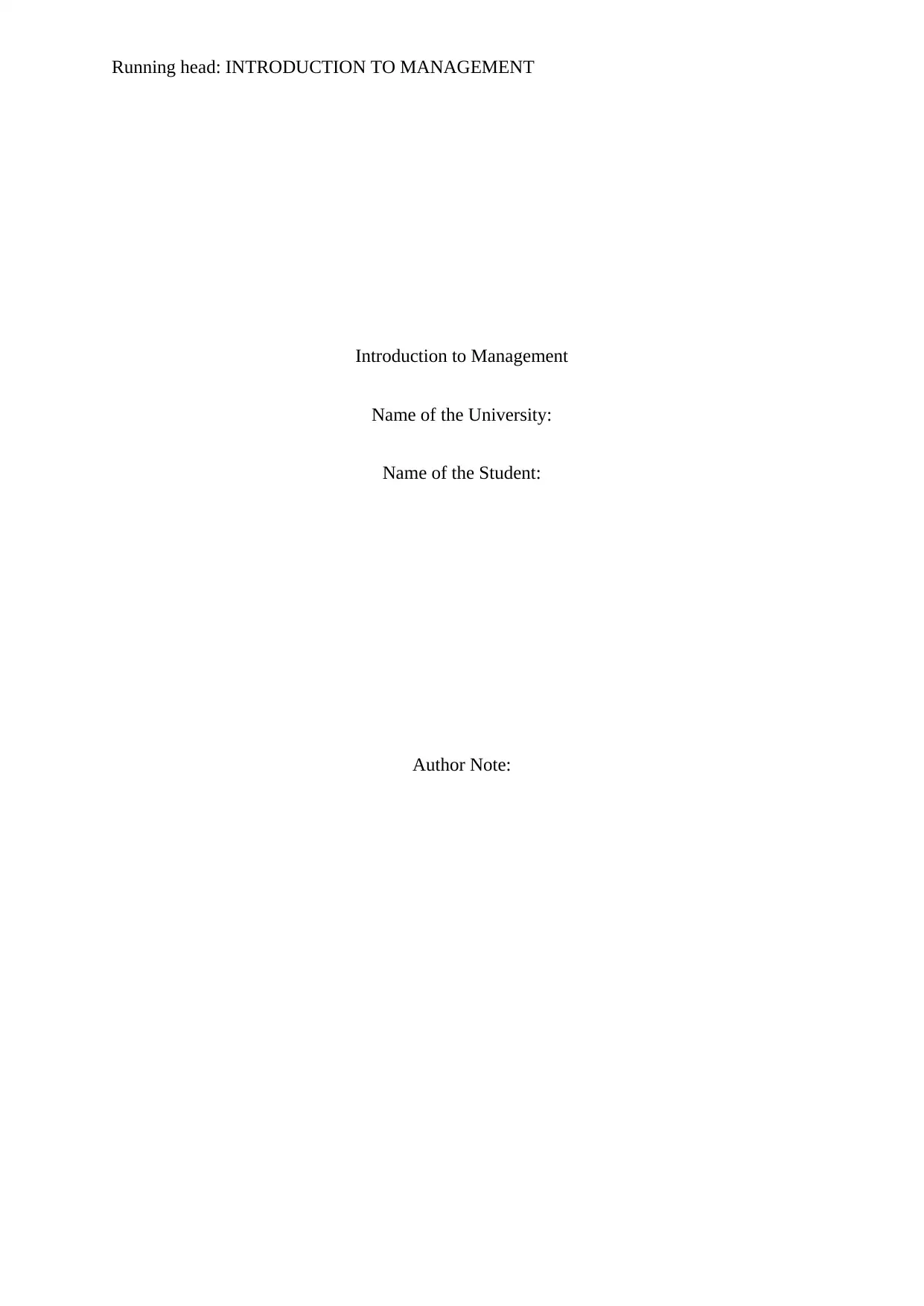
Running head: INTRODUCTION TO MANAGEMENT
Introduction to Management
Name of the University:
Name of the Student:
Author Note:
Introduction to Management
Name of the University:
Name of the Student:
Author Note:
Paraphrase This Document
Need a fresh take? Get an instant paraphrase of this document with our AI Paraphraser
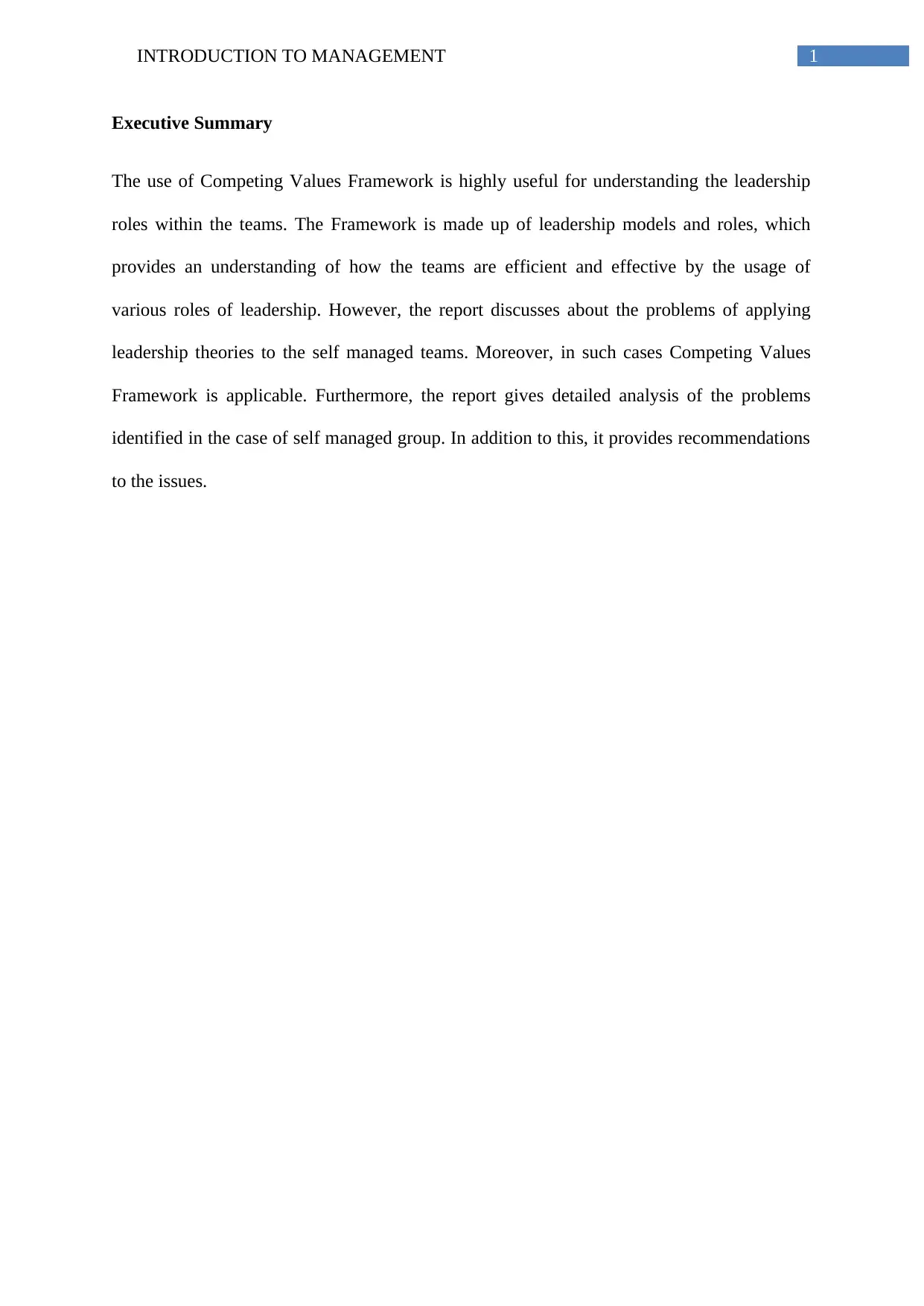
1INTRODUCTION TO MANAGEMENT
Executive Summary
The use of Competing Values Framework is highly useful for understanding the leadership
roles within the teams. The Framework is made up of leadership models and roles, which
provides an understanding of how the teams are efficient and effective by the usage of
various roles of leadership. However, the report discusses about the problems of applying
leadership theories to the self managed teams. Moreover, in such cases Competing Values
Framework is applicable. Furthermore, the report gives detailed analysis of the problems
identified in the case of self managed group. In addition to this, it provides recommendations
to the issues.
Executive Summary
The use of Competing Values Framework is highly useful for understanding the leadership
roles within the teams. The Framework is made up of leadership models and roles, which
provides an understanding of how the teams are efficient and effective by the usage of
various roles of leadership. However, the report discusses about the problems of applying
leadership theories to the self managed teams. Moreover, in such cases Competing Values
Framework is applicable. Furthermore, the report gives detailed analysis of the problems
identified in the case of self managed group. In addition to this, it provides recommendations
to the issues.
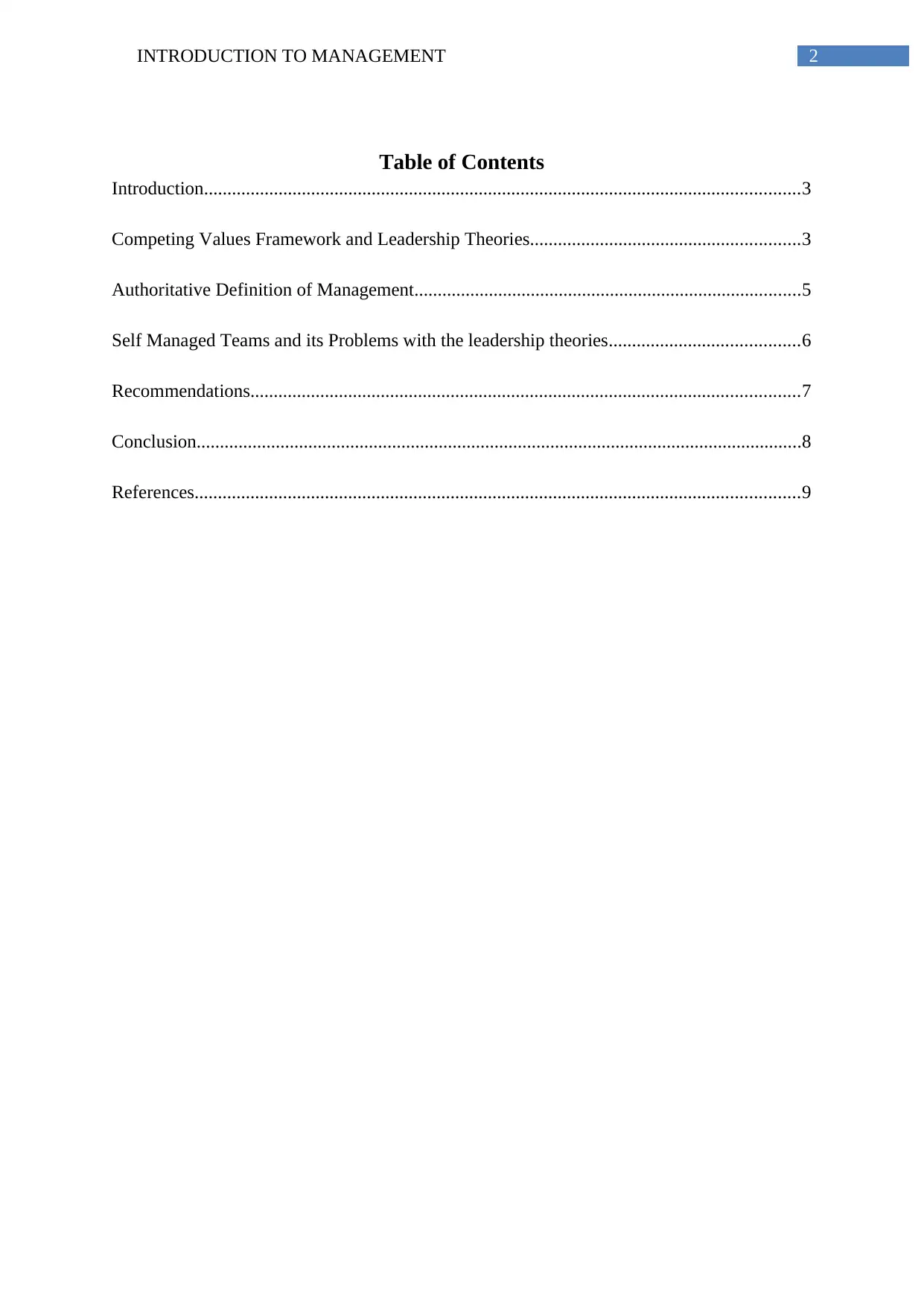
2INTRODUCTION TO MANAGEMENT
Table of Contents
Introduction................................................................................................................................3
Competing Values Framework and Leadership Theories..........................................................3
Authoritative Definition of Management...................................................................................5
Self Managed Teams and its Problems with the leadership theories.........................................6
Recommendations......................................................................................................................7
Conclusion..................................................................................................................................8
References..................................................................................................................................9
Table of Contents
Introduction................................................................................................................................3
Competing Values Framework and Leadership Theories..........................................................3
Authoritative Definition of Management...................................................................................5
Self Managed Teams and its Problems with the leadership theories.........................................6
Recommendations......................................................................................................................7
Conclusion..................................................................................................................................8
References..................................................................................................................................9
⊘ This is a preview!⊘
Do you want full access?
Subscribe today to unlock all pages.

Trusted by 1+ million students worldwide
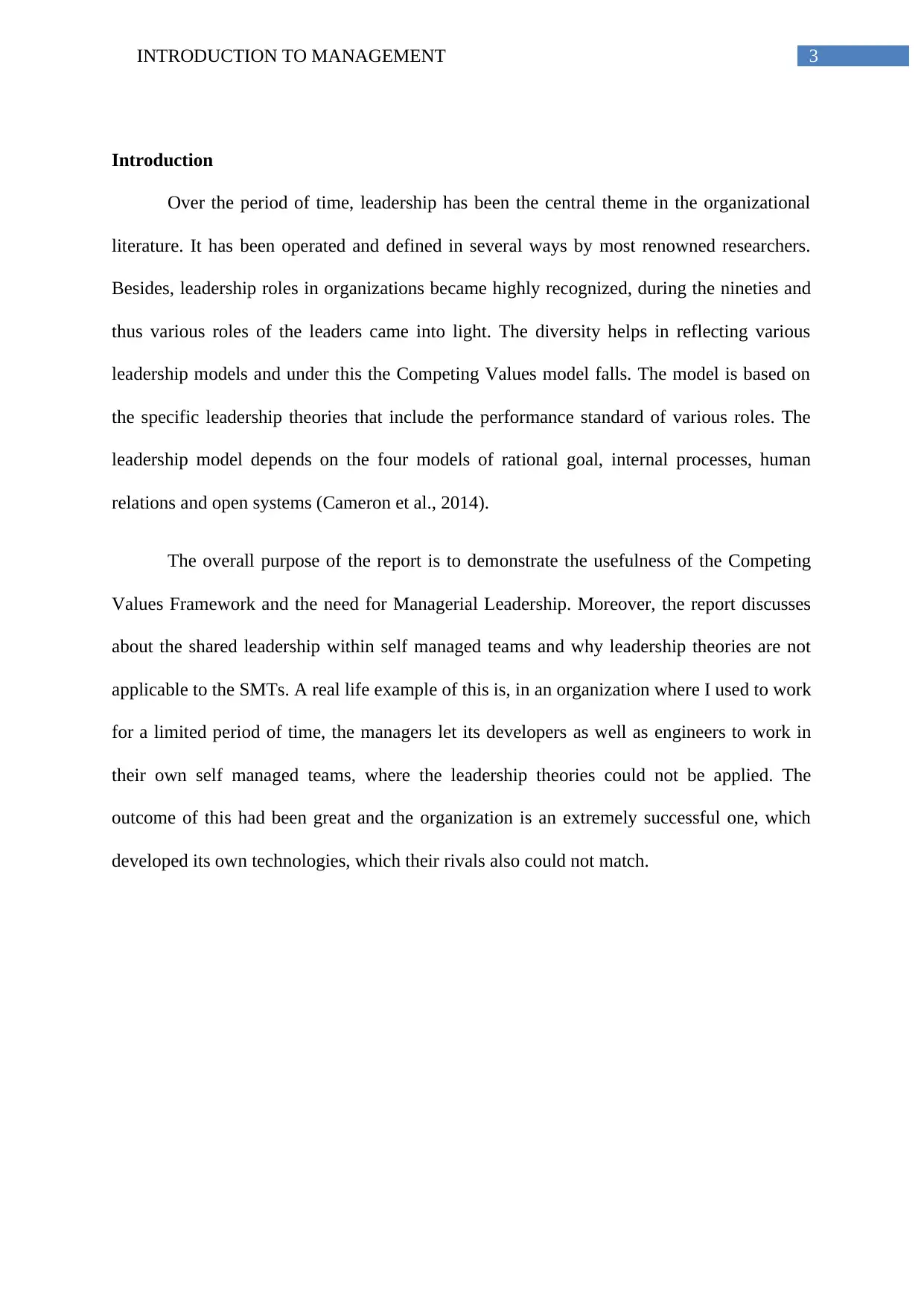
3INTRODUCTION TO MANAGEMENT
Introduction
Over the period of time, leadership has been the central theme in the organizational
literature. It has been operated and defined in several ways by most renowned researchers.
Besides, leadership roles in organizations became highly recognized, during the nineties and
thus various roles of the leaders came into light. The diversity helps in reflecting various
leadership models and under this the Competing Values model falls. The model is based on
the specific leadership theories that include the performance standard of various roles. The
leadership model depends on the four models of rational goal, internal processes, human
relations and open systems (Cameron et al., 2014).
The overall purpose of the report is to demonstrate the usefulness of the Competing
Values Framework and the need for Managerial Leadership. Moreover, the report discusses
about the shared leadership within self managed teams and why leadership theories are not
applicable to the SMTs. A real life example of this is, in an organization where I used to work
for a limited period of time, the managers let its developers as well as engineers to work in
their own self managed teams, where the leadership theories could not be applied. The
outcome of this had been great and the organization is an extremely successful one, which
developed its own technologies, which their rivals also could not match.
Introduction
Over the period of time, leadership has been the central theme in the organizational
literature. It has been operated and defined in several ways by most renowned researchers.
Besides, leadership roles in organizations became highly recognized, during the nineties and
thus various roles of the leaders came into light. The diversity helps in reflecting various
leadership models and under this the Competing Values model falls. The model is based on
the specific leadership theories that include the performance standard of various roles. The
leadership model depends on the four models of rational goal, internal processes, human
relations and open systems (Cameron et al., 2014).
The overall purpose of the report is to demonstrate the usefulness of the Competing
Values Framework and the need for Managerial Leadership. Moreover, the report discusses
about the shared leadership within self managed teams and why leadership theories are not
applicable to the SMTs. A real life example of this is, in an organization where I used to work
for a limited period of time, the managers let its developers as well as engineers to work in
their own self managed teams, where the leadership theories could not be applied. The
outcome of this had been great and the organization is an extremely successful one, which
developed its own technologies, which their rivals also could not match.
Paraphrase This Document
Need a fresh take? Get an instant paraphrase of this document with our AI Paraphraser

4INTRODUCTION TO MANAGEMENT
Competing Values Framework and Leadership Theories
(Figure: Competing Values Framework
Source: Gimenez-Espin, Jiménez-Jiménez & Martínez-Costa, 2013)
The model of human relations includes the roles of mentor as well as facilitator. It
emphasizes on cohesion, morale and commitment. The involvement results into commitment
as well as the core values, which are consensus building, conflict resolution and participation.
The specific role of the managers is to become a process focused facilitator as well as an
empathetic mentor. The facilitators motivate and encourage the collective efforts of the
employees, promote team work and cohesion and also manage personal conflicts. The
mentors completely dedicate themselves in order to develop people through careful empathy
and guidance. The manager highly contributes to planning and enhancing skills which the
individuals develop among themselves (Kim, 2014).
The open system model results from the leadership needs in a changed world, where
changes are rapid and knowledge is vast. On one hand, the leaders have very little time to
organize a company and make plans for their development, while on the other the leaders are
Competing Values Framework and Leadership Theories
(Figure: Competing Values Framework
Source: Gimenez-Espin, Jiménez-Jiménez & Martínez-Costa, 2013)
The model of human relations includes the roles of mentor as well as facilitator. It
emphasizes on cohesion, morale and commitment. The involvement results into commitment
as well as the core values, which are consensus building, conflict resolution and participation.
The specific role of the managers is to become a process focused facilitator as well as an
empathetic mentor. The facilitators motivate and encourage the collective efforts of the
employees, promote team work and cohesion and also manage personal conflicts. The
mentors completely dedicate themselves in order to develop people through careful empathy
and guidance. The manager highly contributes to planning and enhancing skills which the
individuals develop among themselves (Kim, 2014).
The open system model results from the leadership needs in a changed world, where
changes are rapid and knowledge is vast. On one hand, the leaders have very little time to
organize a company and make plans for their development, while on the other the leaders are
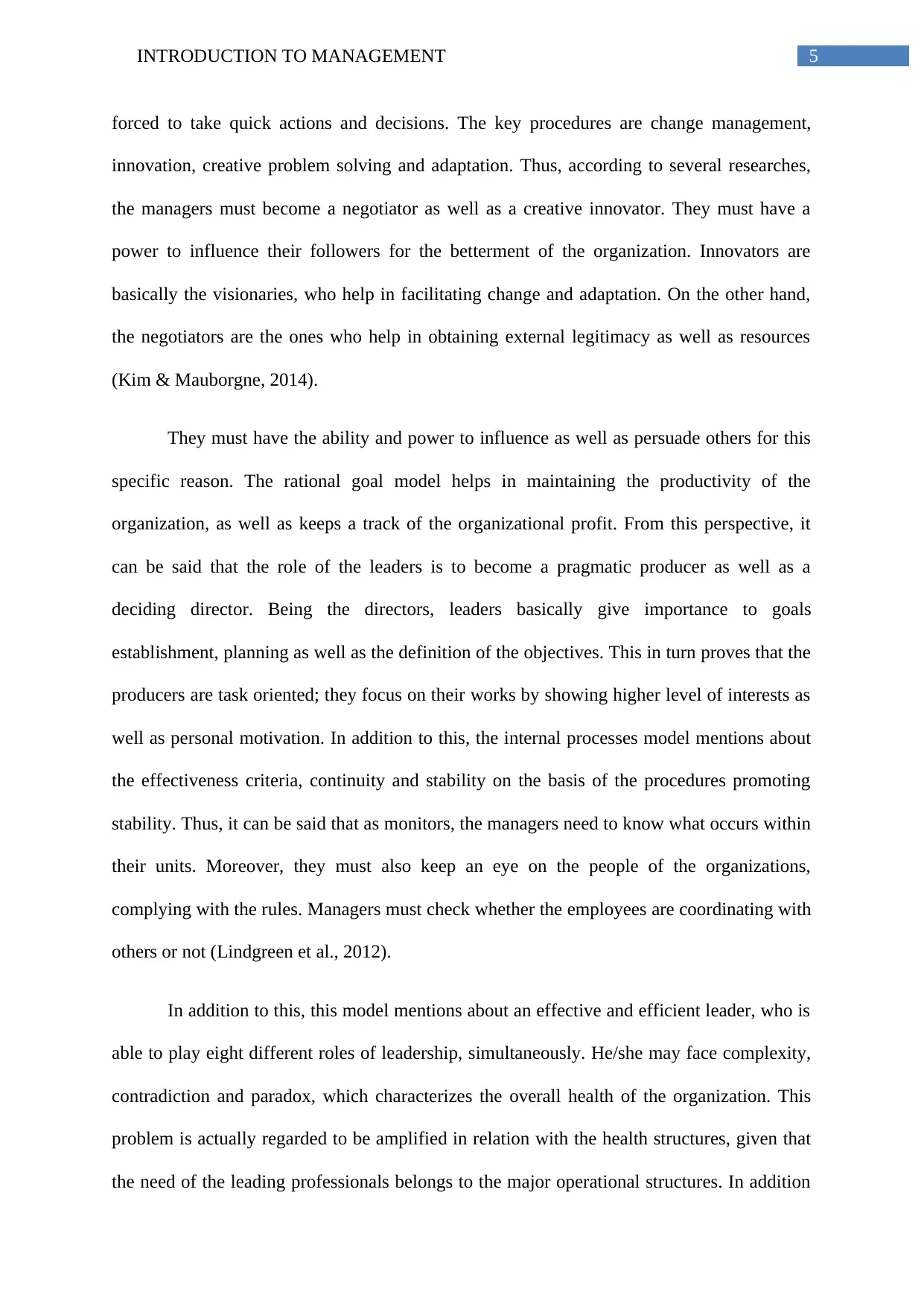
5INTRODUCTION TO MANAGEMENT
forced to take quick actions and decisions. The key procedures are change management,
innovation, creative problem solving and adaptation. Thus, according to several researches,
the managers must become a negotiator as well as a creative innovator. They must have a
power to influence their followers for the betterment of the organization. Innovators are
basically the visionaries, who help in facilitating change and adaptation. On the other hand,
the negotiators are the ones who help in obtaining external legitimacy as well as resources
(Kim & Mauborgne, 2014).
They must have the ability and power to influence as well as persuade others for this
specific reason. The rational goal model helps in maintaining the productivity of the
organization, as well as keeps a track of the organizational profit. From this perspective, it
can be said that the role of the leaders is to become a pragmatic producer as well as a
deciding director. Being the directors, leaders basically give importance to goals
establishment, planning as well as the definition of the objectives. This in turn proves that the
producers are task oriented; they focus on their works by showing higher level of interests as
well as personal motivation. In addition to this, the internal processes model mentions about
the effectiveness criteria, continuity and stability on the basis of the procedures promoting
stability. Thus, it can be said that as monitors, the managers need to know what occurs within
their units. Moreover, they must also keep an eye on the people of the organizations,
complying with the rules. Managers must check whether the employees are coordinating with
others or not (Lindgreen et al., 2012).
In addition to this, this model mentions about an effective and efficient leader, who is
able to play eight different roles of leadership, simultaneously. He/she may face complexity,
contradiction and paradox, which characterizes the overall health of the organization. This
problem is actually regarded to be amplified in relation with the health structures, given that
the need of the leading professionals belongs to the major operational structures. In addition
forced to take quick actions and decisions. The key procedures are change management,
innovation, creative problem solving and adaptation. Thus, according to several researches,
the managers must become a negotiator as well as a creative innovator. They must have a
power to influence their followers for the betterment of the organization. Innovators are
basically the visionaries, who help in facilitating change and adaptation. On the other hand,
the negotiators are the ones who help in obtaining external legitimacy as well as resources
(Kim & Mauborgne, 2014).
They must have the ability and power to influence as well as persuade others for this
specific reason. The rational goal model helps in maintaining the productivity of the
organization, as well as keeps a track of the organizational profit. From this perspective, it
can be said that the role of the leaders is to become a pragmatic producer as well as a
deciding director. Being the directors, leaders basically give importance to goals
establishment, planning as well as the definition of the objectives. This in turn proves that the
producers are task oriented; they focus on their works by showing higher level of interests as
well as personal motivation. In addition to this, the internal processes model mentions about
the effectiveness criteria, continuity and stability on the basis of the procedures promoting
stability. Thus, it can be said that as monitors, the managers need to know what occurs within
their units. Moreover, they must also keep an eye on the people of the organizations,
complying with the rules. Managers must check whether the employees are coordinating with
others or not (Lindgreen et al., 2012).
In addition to this, this model mentions about an effective and efficient leader, who is
able to play eight different roles of leadership, simultaneously. He/she may face complexity,
contradiction and paradox, which characterizes the overall health of the organization. This
problem is actually regarded to be amplified in relation with the health structures, given that
the need of the leading professionals belongs to the major operational structures. In addition
⊘ This is a preview!⊘
Do you want full access?
Subscribe today to unlock all pages.

Trusted by 1+ million students worldwide
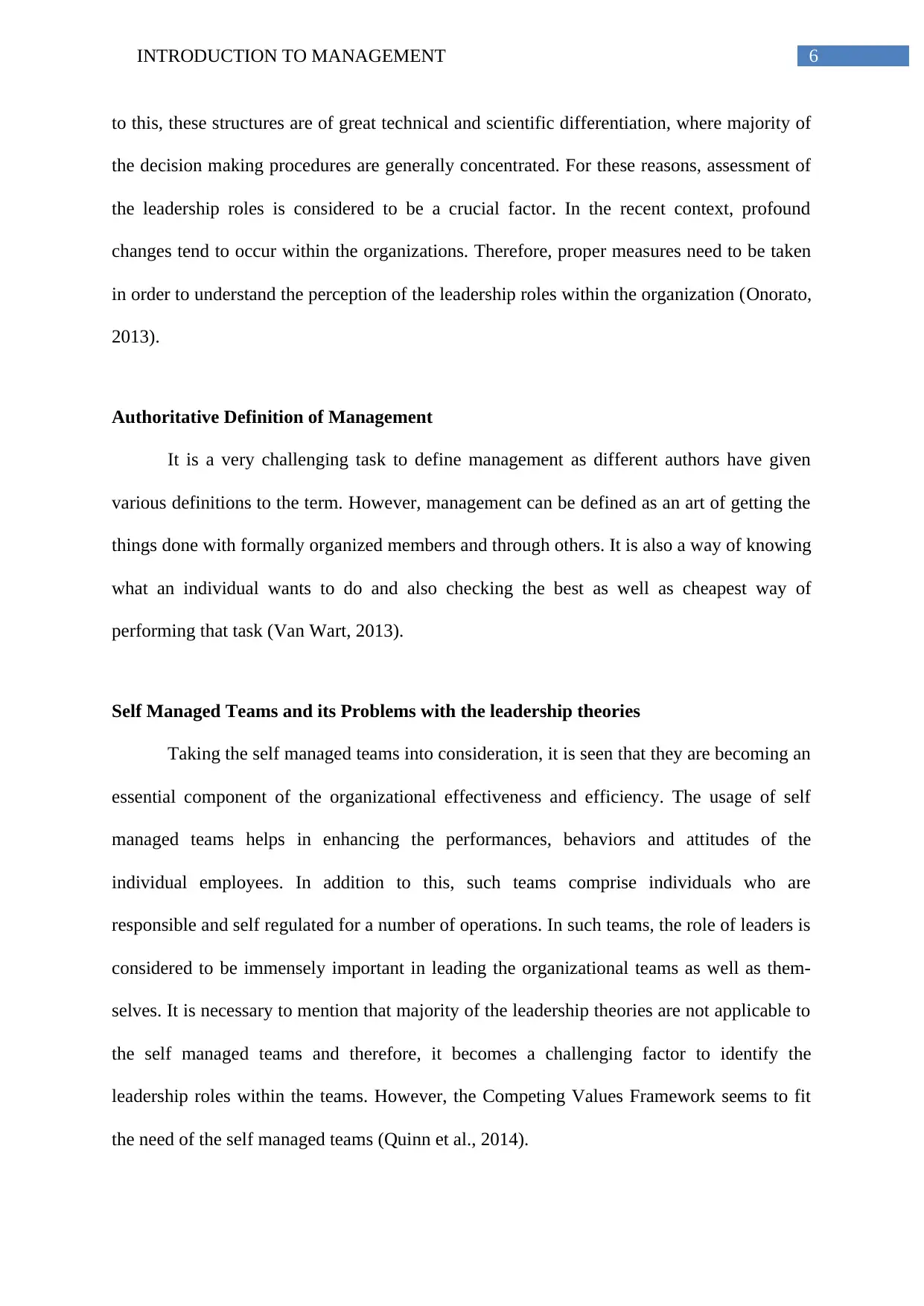
6INTRODUCTION TO MANAGEMENT
to this, these structures are of great technical and scientific differentiation, where majority of
the decision making procedures are generally concentrated. For these reasons, assessment of
the leadership roles is considered to be a crucial factor. In the recent context, profound
changes tend to occur within the organizations. Therefore, proper measures need to be taken
in order to understand the perception of the leadership roles within the organization (Onorato,
2013).
Authoritative Definition of Management
It is a very challenging task to define management as different authors have given
various definitions to the term. However, management can be defined as an art of getting the
things done with formally organized members and through others. It is also a way of knowing
what an individual wants to do and also checking the best as well as cheapest way of
performing that task (Van Wart, 2013).
Self Managed Teams and its Problems with the leadership theories
Taking the self managed teams into consideration, it is seen that they are becoming an
essential component of the organizational effectiveness and efficiency. The usage of self
managed teams helps in enhancing the performances, behaviors and attitudes of the
individual employees. In addition to this, such teams comprise individuals who are
responsible and self regulated for a number of operations. In such teams, the role of leaders is
considered to be immensely important in leading the organizational teams as well as them-
selves. It is necessary to mention that majority of the leadership theories are not applicable to
the self managed teams and therefore, it becomes a challenging factor to identify the
leadership roles within the teams. However, the Competing Values Framework seems to fit
the need of the self managed teams (Quinn et al., 2014).
to this, these structures are of great technical and scientific differentiation, where majority of
the decision making procedures are generally concentrated. For these reasons, assessment of
the leadership roles is considered to be a crucial factor. In the recent context, profound
changes tend to occur within the organizations. Therefore, proper measures need to be taken
in order to understand the perception of the leadership roles within the organization (Onorato,
2013).
Authoritative Definition of Management
It is a very challenging task to define management as different authors have given
various definitions to the term. However, management can be defined as an art of getting the
things done with formally organized members and through others. It is also a way of knowing
what an individual wants to do and also checking the best as well as cheapest way of
performing that task (Van Wart, 2013).
Self Managed Teams and its Problems with the leadership theories
Taking the self managed teams into consideration, it is seen that they are becoming an
essential component of the organizational effectiveness and efficiency. The usage of self
managed teams helps in enhancing the performances, behaviors and attitudes of the
individual employees. In addition to this, such teams comprise individuals who are
responsible and self regulated for a number of operations. In such teams, the role of leaders is
considered to be immensely important in leading the organizational teams as well as them-
selves. It is necessary to mention that majority of the leadership theories are not applicable to
the self managed teams and therefore, it becomes a challenging factor to identify the
leadership roles within the teams. However, the Competing Values Framework seems to fit
the need of the self managed teams (Quinn et al., 2014).
Paraphrase This Document
Need a fresh take? Get an instant paraphrase of this document with our AI Paraphraser
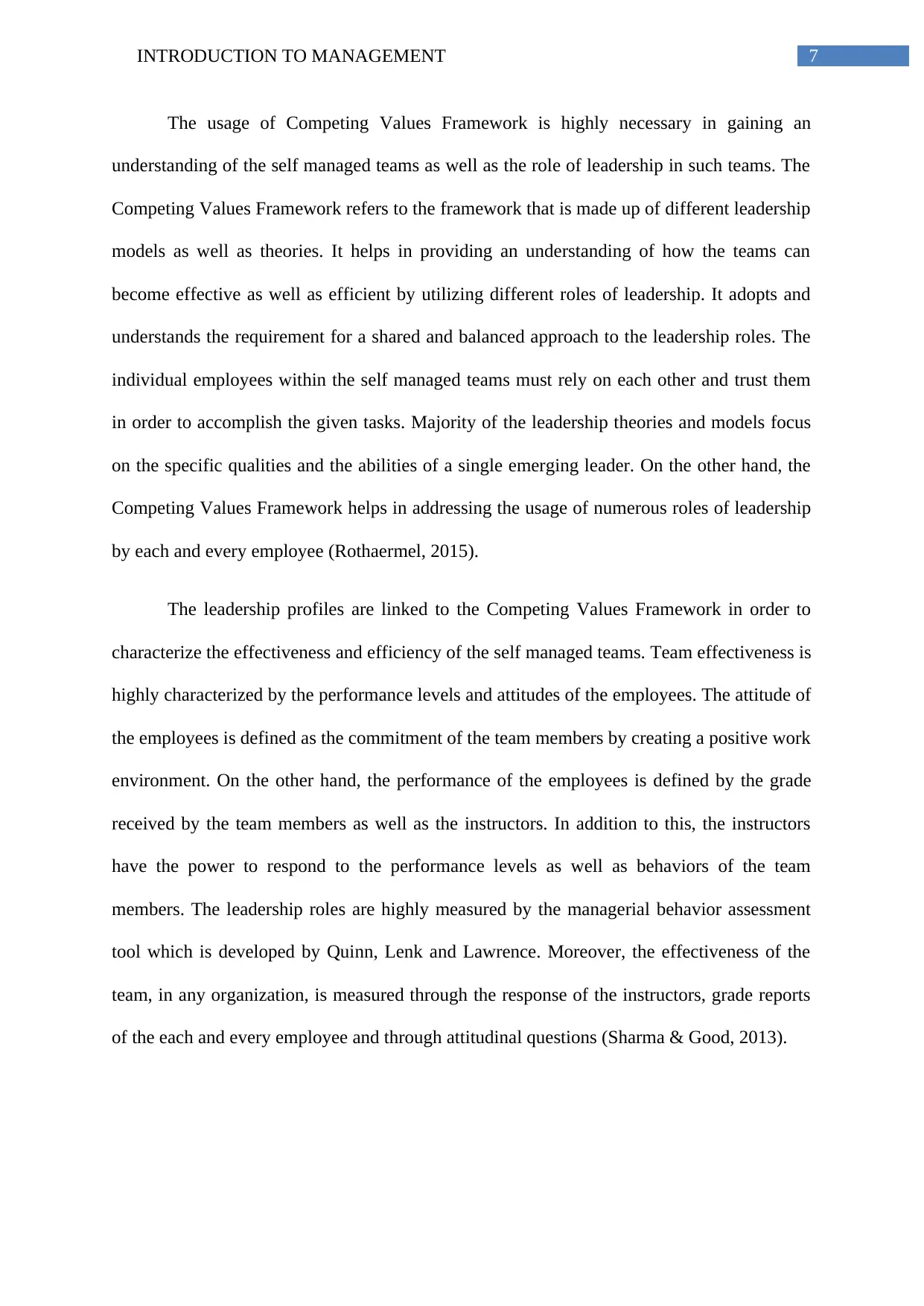
7INTRODUCTION TO MANAGEMENT
The usage of Competing Values Framework is highly necessary in gaining an
understanding of the self managed teams as well as the role of leadership in such teams. The
Competing Values Framework refers to the framework that is made up of different leadership
models as well as theories. It helps in providing an understanding of how the teams can
become effective as well as efficient by utilizing different roles of leadership. It adopts and
understands the requirement for a shared and balanced approach to the leadership roles. The
individual employees within the self managed teams must rely on each other and trust them
in order to accomplish the given tasks. Majority of the leadership theories and models focus
on the specific qualities and the abilities of a single emerging leader. On the other hand, the
Competing Values Framework helps in addressing the usage of numerous roles of leadership
by each and every employee (Rothaermel, 2015).
The leadership profiles are linked to the Competing Values Framework in order to
characterize the effectiveness and efficiency of the self managed teams. Team effectiveness is
highly characterized by the performance levels and attitudes of the employees. The attitude of
the employees is defined as the commitment of the team members by creating a positive work
environment. On the other hand, the performance of the employees is defined by the grade
received by the team members as well as the instructors. In addition to this, the instructors
have the power to respond to the performance levels as well as behaviors of the team
members. The leadership roles are highly measured by the managerial behavior assessment
tool which is developed by Quinn, Lenk and Lawrence. Moreover, the effectiveness of the
team, in any organization, is measured through the response of the instructors, grade reports
of the each and every employee and through attitudinal questions (Sharma & Good, 2013).
The usage of Competing Values Framework is highly necessary in gaining an
understanding of the self managed teams as well as the role of leadership in such teams. The
Competing Values Framework refers to the framework that is made up of different leadership
models as well as theories. It helps in providing an understanding of how the teams can
become effective as well as efficient by utilizing different roles of leadership. It adopts and
understands the requirement for a shared and balanced approach to the leadership roles. The
individual employees within the self managed teams must rely on each other and trust them
in order to accomplish the given tasks. Majority of the leadership theories and models focus
on the specific qualities and the abilities of a single emerging leader. On the other hand, the
Competing Values Framework helps in addressing the usage of numerous roles of leadership
by each and every employee (Rothaermel, 2015).
The leadership profiles are linked to the Competing Values Framework in order to
characterize the effectiveness and efficiency of the self managed teams. Team effectiveness is
highly characterized by the performance levels and attitudes of the employees. The attitude of
the employees is defined as the commitment of the team members by creating a positive work
environment. On the other hand, the performance of the employees is defined by the grade
received by the team members as well as the instructors. In addition to this, the instructors
have the power to respond to the performance levels as well as behaviors of the team
members. The leadership roles are highly measured by the managerial behavior assessment
tool which is developed by Quinn, Lenk and Lawrence. Moreover, the effectiveness of the
team, in any organization, is measured through the response of the instructors, grade reports
of the each and every employee and through attitudinal questions (Sharma & Good, 2013).
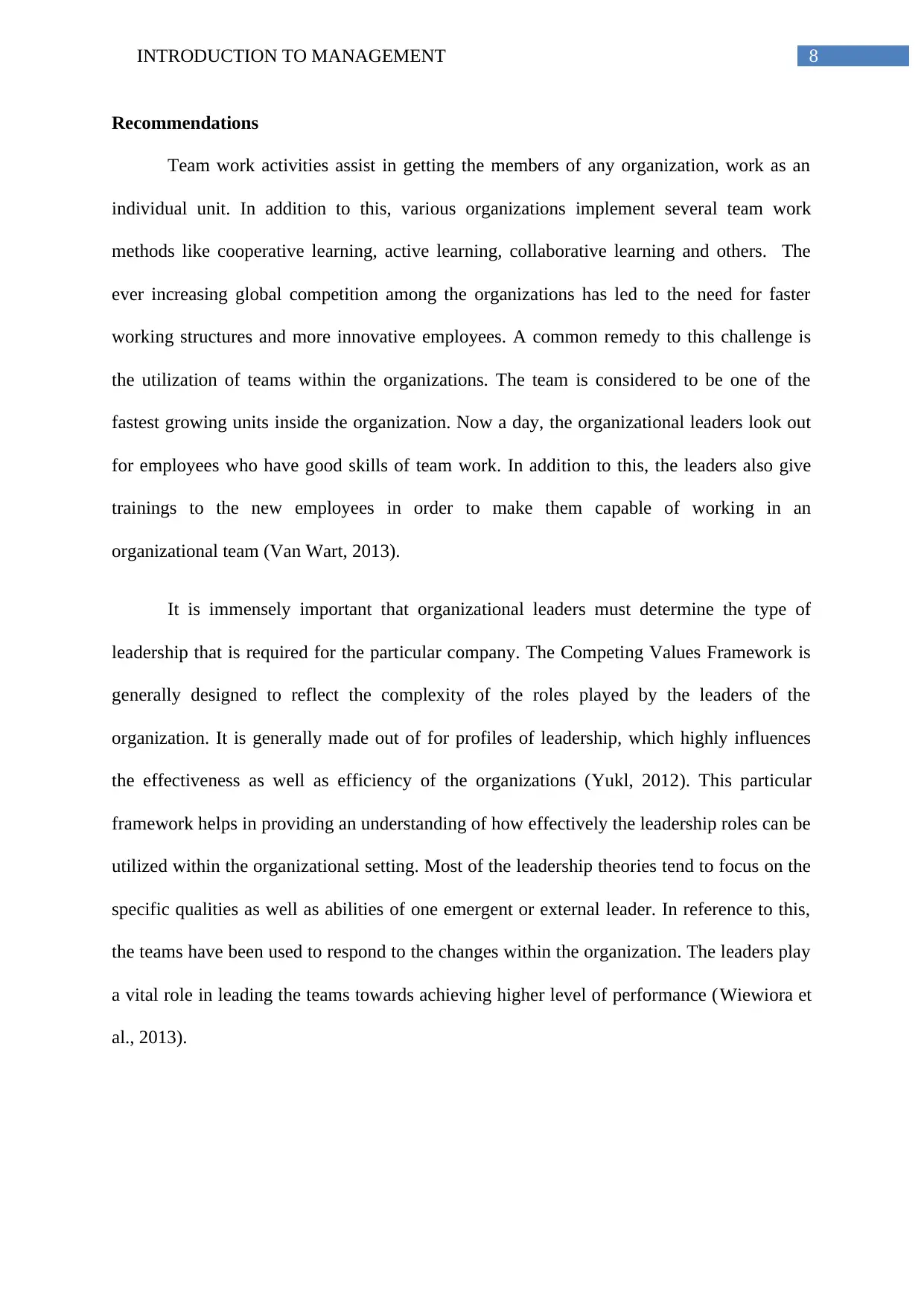
8INTRODUCTION TO MANAGEMENT
Recommendations
Team work activities assist in getting the members of any organization, work as an
individual unit. In addition to this, various organizations implement several team work
methods like cooperative learning, active learning, collaborative learning and others. The
ever increasing global competition among the organizations has led to the need for faster
working structures and more innovative employees. A common remedy to this challenge is
the utilization of teams within the organizations. The team is considered to be one of the
fastest growing units inside the organization. Now a day, the organizational leaders look out
for employees who have good skills of team work. In addition to this, the leaders also give
trainings to the new employees in order to make them capable of working in an
organizational team (Van Wart, 2013).
It is immensely important that organizational leaders must determine the type of
leadership that is required for the particular company. The Competing Values Framework is
generally designed to reflect the complexity of the roles played by the leaders of the
organization. It is generally made out of for profiles of leadership, which highly influences
the effectiveness as well as efficiency of the organizations (Yukl, 2012). This particular
framework helps in providing an understanding of how effectively the leadership roles can be
utilized within the organizational setting. Most of the leadership theories tend to focus on the
specific qualities as well as abilities of one emergent or external leader. In reference to this,
the teams have been used to respond to the changes within the organization. The leaders play
a vital role in leading the teams towards achieving higher level of performance (Wiewiora et
al., 2013).
Recommendations
Team work activities assist in getting the members of any organization, work as an
individual unit. In addition to this, various organizations implement several team work
methods like cooperative learning, active learning, collaborative learning and others. The
ever increasing global competition among the organizations has led to the need for faster
working structures and more innovative employees. A common remedy to this challenge is
the utilization of teams within the organizations. The team is considered to be one of the
fastest growing units inside the organization. Now a day, the organizational leaders look out
for employees who have good skills of team work. In addition to this, the leaders also give
trainings to the new employees in order to make them capable of working in an
organizational team (Van Wart, 2013).
It is immensely important that organizational leaders must determine the type of
leadership that is required for the particular company. The Competing Values Framework is
generally designed to reflect the complexity of the roles played by the leaders of the
organization. It is generally made out of for profiles of leadership, which highly influences
the effectiveness as well as efficiency of the organizations (Yukl, 2012). This particular
framework helps in providing an understanding of how effectively the leadership roles can be
utilized within the organizational setting. Most of the leadership theories tend to focus on the
specific qualities as well as abilities of one emergent or external leader. In reference to this,
the teams have been used to respond to the changes within the organization. The leaders play
a vital role in leading the teams towards achieving higher level of performance (Wiewiora et
al., 2013).
⊘ This is a preview!⊘
Do you want full access?
Subscribe today to unlock all pages.

Trusted by 1+ million students worldwide
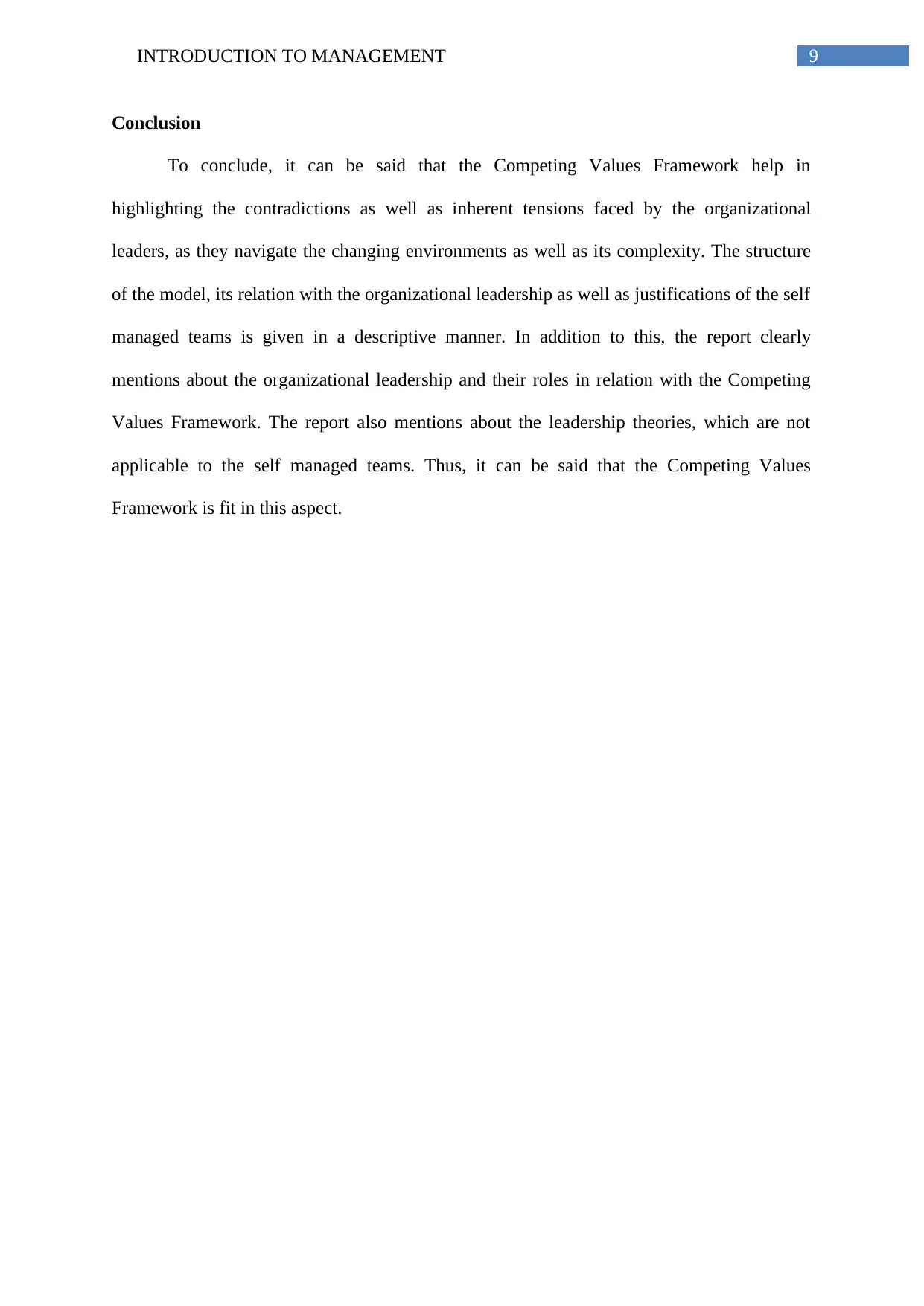
9INTRODUCTION TO MANAGEMENT
Conclusion
To conclude, it can be said that the Competing Values Framework help in
highlighting the contradictions as well as inherent tensions faced by the organizational
leaders, as they navigate the changing environments as well as its complexity. The structure
of the model, its relation with the organizational leadership as well as justifications of the self
managed teams is given in a descriptive manner. In addition to this, the report clearly
mentions about the organizational leadership and their roles in relation with the Competing
Values Framework. The report also mentions about the leadership theories, which are not
applicable to the self managed teams. Thus, it can be said that the Competing Values
Framework is fit in this aspect.
Conclusion
To conclude, it can be said that the Competing Values Framework help in
highlighting the contradictions as well as inherent tensions faced by the organizational
leaders, as they navigate the changing environments as well as its complexity. The structure
of the model, its relation with the organizational leadership as well as justifications of the self
managed teams is given in a descriptive manner. In addition to this, the report clearly
mentions about the organizational leadership and their roles in relation with the Competing
Values Framework. The report also mentions about the leadership theories, which are not
applicable to the self managed teams. Thus, it can be said that the Competing Values
Framework is fit in this aspect.
Paraphrase This Document
Need a fresh take? Get an instant paraphrase of this document with our AI Paraphraser
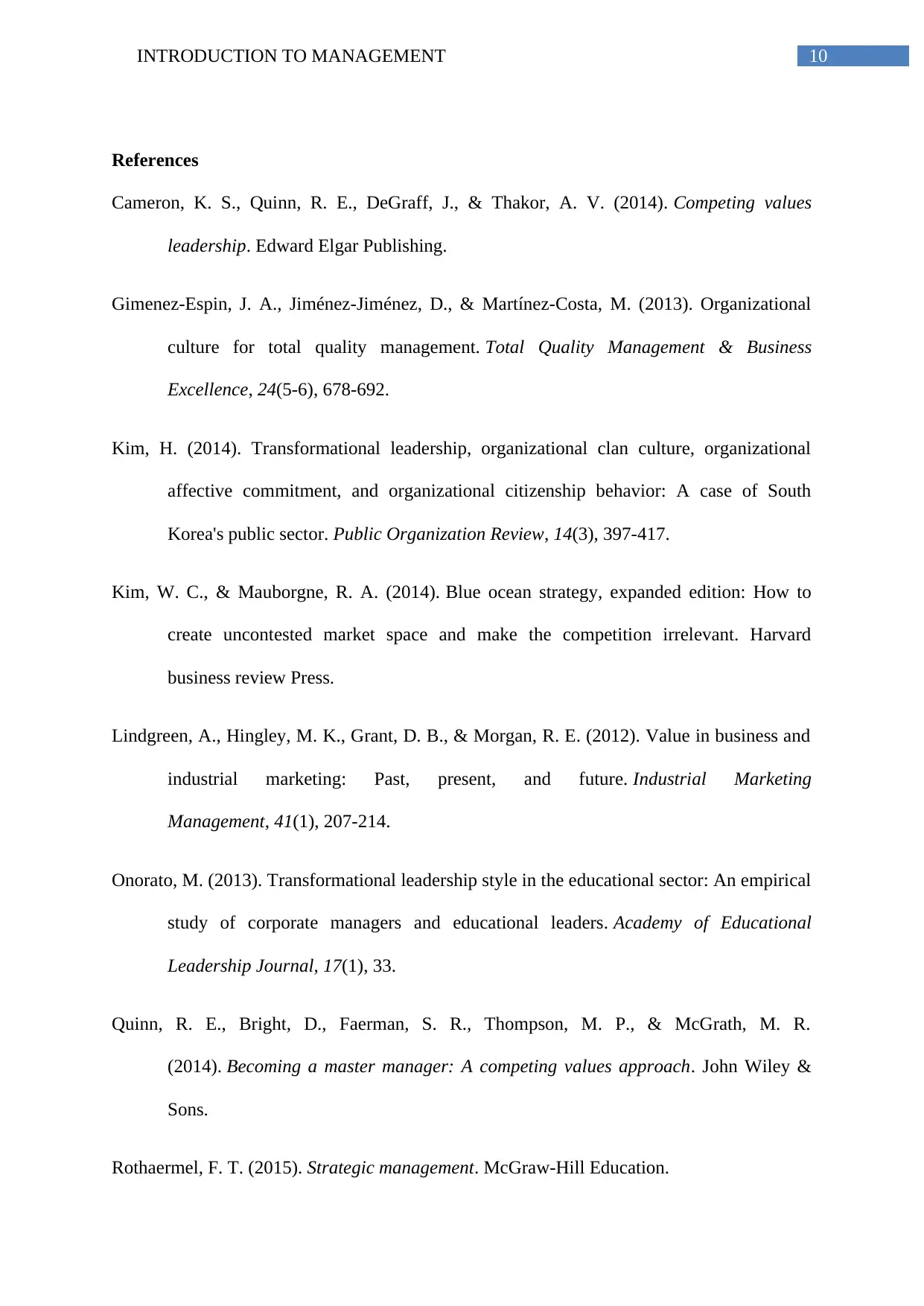
10INTRODUCTION TO MANAGEMENT
References
Cameron, K. S., Quinn, R. E., DeGraff, J., & Thakor, A. V. (2014). Competing values
leadership. Edward Elgar Publishing.
Gimenez-Espin, J. A., Jiménez-Jiménez, D., & Martínez-Costa, M. (2013). Organizational
culture for total quality management. Total Quality Management & Business
Excellence, 24(5-6), 678-692.
Kim, H. (2014). Transformational leadership, organizational clan culture, organizational
affective commitment, and organizational citizenship behavior: A case of South
Korea's public sector. Public Organization Review, 14(3), 397-417.
Kim, W. C., & Mauborgne, R. A. (2014). Blue ocean strategy, expanded edition: How to
create uncontested market space and make the competition irrelevant. Harvard
business review Press.
Lindgreen, A., Hingley, M. K., Grant, D. B., & Morgan, R. E. (2012). Value in business and
industrial marketing: Past, present, and future. Industrial Marketing
Management, 41(1), 207-214.
Onorato, M. (2013). Transformational leadership style in the educational sector: An empirical
study of corporate managers and educational leaders. Academy of Educational
Leadership Journal, 17(1), 33.
Quinn, R. E., Bright, D., Faerman, S. R., Thompson, M. P., & McGrath, M. R.
(2014). Becoming a master manager: A competing values approach. John Wiley &
Sons.
Rothaermel, F. T. (2015). Strategic management. McGraw-Hill Education.
References
Cameron, K. S., Quinn, R. E., DeGraff, J., & Thakor, A. V. (2014). Competing values
leadership. Edward Elgar Publishing.
Gimenez-Espin, J. A., Jiménez-Jiménez, D., & Martínez-Costa, M. (2013). Organizational
culture for total quality management. Total Quality Management & Business
Excellence, 24(5-6), 678-692.
Kim, H. (2014). Transformational leadership, organizational clan culture, organizational
affective commitment, and organizational citizenship behavior: A case of South
Korea's public sector. Public Organization Review, 14(3), 397-417.
Kim, W. C., & Mauborgne, R. A. (2014). Blue ocean strategy, expanded edition: How to
create uncontested market space and make the competition irrelevant. Harvard
business review Press.
Lindgreen, A., Hingley, M. K., Grant, D. B., & Morgan, R. E. (2012). Value in business and
industrial marketing: Past, present, and future. Industrial Marketing
Management, 41(1), 207-214.
Onorato, M. (2013). Transformational leadership style in the educational sector: An empirical
study of corporate managers and educational leaders. Academy of Educational
Leadership Journal, 17(1), 33.
Quinn, R. E., Bright, D., Faerman, S. R., Thompson, M. P., & McGrath, M. R.
(2014). Becoming a master manager: A competing values approach. John Wiley &
Sons.
Rothaermel, F. T. (2015). Strategic management. McGraw-Hill Education.

11INTRODUCTION TO MANAGEMENT
Sharma, G., & Good, D. (2013). The work of middle managers: Sensemaking and
sensegiving for creating positive social change. The Journal of Applied Behavioral
Science, 49(1), 95-122.
Van Wart, M. (2013). Lessons from leadership theory and the contemporary challenges of
leaders. Public Administration Review, 73(4), 553-565.
Wiewiora, A., Trigunarsyah, B., Murphy, G., & Coffey, V. (2013). Organizational culture
and willingness to share knowledge: A competing values perspective in Australian
context. International Journal of Project Management, 31(8), 1163-1174.
Yukl, G. (2012). Effective leadership behavior: What we know and what questions need more
attention. The Academy of Management Perspectives, 26(4), 66-85.
Sharma, G., & Good, D. (2013). The work of middle managers: Sensemaking and
sensegiving for creating positive social change. The Journal of Applied Behavioral
Science, 49(1), 95-122.
Van Wart, M. (2013). Lessons from leadership theory and the contemporary challenges of
leaders. Public Administration Review, 73(4), 553-565.
Wiewiora, A., Trigunarsyah, B., Murphy, G., & Coffey, V. (2013). Organizational culture
and willingness to share knowledge: A competing values perspective in Australian
context. International Journal of Project Management, 31(8), 1163-1174.
Yukl, G. (2012). Effective leadership behavior: What we know and what questions need more
attention. The Academy of Management Perspectives, 26(4), 66-85.
⊘ This is a preview!⊘
Do you want full access?
Subscribe today to unlock all pages.

Trusted by 1+ million students worldwide
1 out of 12
Related Documents
Your All-in-One AI-Powered Toolkit for Academic Success.
+13062052269
info@desklib.com
Available 24*7 on WhatsApp / Email
![[object Object]](/_next/static/media/star-bottom.7253800d.svg)
Unlock your academic potential
Copyright © 2020–2025 A2Z Services. All Rights Reserved. Developed and managed by ZUCOL.



